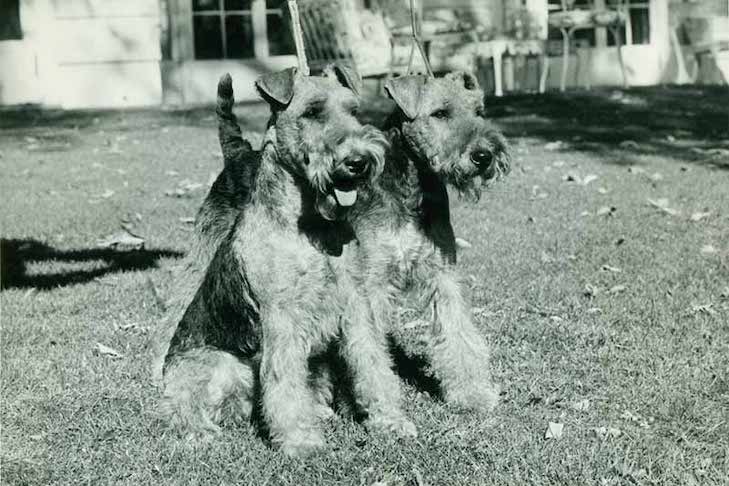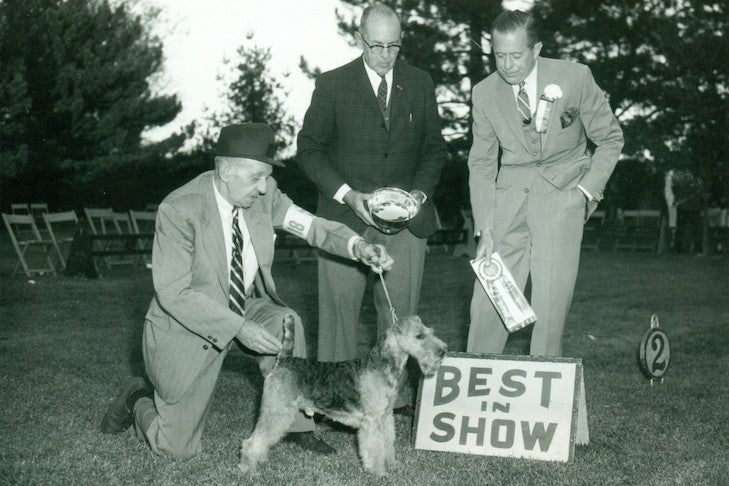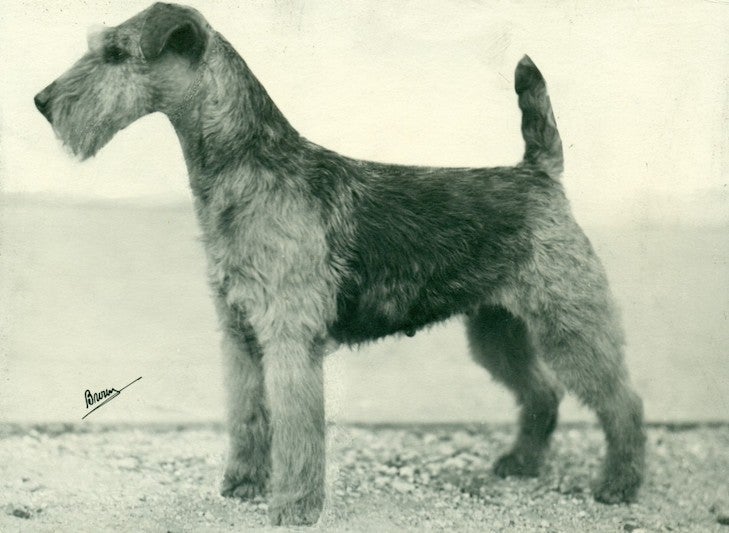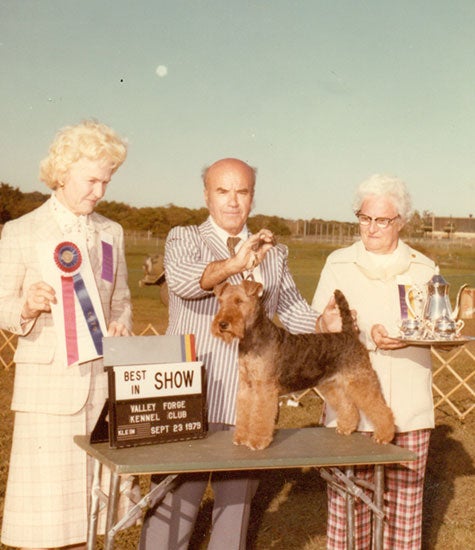
Whenever a canine historian out sets out to research the founding years of a particular terrier, there is always the chance that the research will end in a blind alley for lack of solid, verifiable data on how these dogs came into being. In the case of the Welsh Terrier, one of the oldest of the earthdogs, conjecture and fact coexist regarding its genesis. We do know that the Welsh hails from an ancient canine type and that some form of the breed has been documented for centuries. But there is little documented history after that, until we get to the closing decades of the 19th century.
The history of dog breeds is liberally studded with references to a “black and tan terrier” or an “Old English Black and Tan Terrier,” and it is probable that such a dog was an important progenitor of many early terriers, including the dogs that gave rise to the Welsh. Like the low-stationed terriers of Scotland that evolved from a common generic type, the Welsh undoubtedly sprang from the same gene pool that products all the breeds of the Fox Terrier stamp. With the Welsh, however, there are several significant differences.

A Sporting and Working Terrier
Standing 15 inches at the withers and weighing in at about 20 pounds, the Welsh Terrier is a moderate dog in make and shape. The differences that distinguished the modern terrier breeds were originally dictated by the particular nature of the region in which each breed was developed. The Welsh came to be used as a going-to-ground terrier in the “land of song,” probably in the northern part of the region. The breed was a capable exterminator of fox, badger, and otter, as well as a wide variety of other vermin.
It is important to remember that in previous centuries, dogs had to earn their living. There was little inclination to maintain pets in a society where life was often harsh and people wrested a living from their surroundings. In this environment, terriers had to keep down vermin to protect livestock and stored food supplies. After the day’s work was done there was time for a bit of rat-catching, and this is where the black and tan terrier showed its preeminence.
For many years the Welsh was held in high esteem as a sporting and working terrier; today it is still ready, willing and able to do the job it was originally bred to perform.
Another hallmark of the Welsh Terrier is its distinctive color, a feature which has been its legacy from its Old English ancestors. The blanketed pattern is shared with the Airedale Terrier and, in some cases, the Lakeland. Although the blanket or saddle is most often black, it may also be grizzle; even the blackest saddle may show some red hairs, especially near the tail.
At birth, Welsh Terriers are almost completely black, resembling the color pattern of the Manchester Terrier. As the puppies grow, the black gradually recedes until the pattern takes on the form of the adult dog. In a grown Welsh there should be no black on the head, and any white spot on the chest that a dog may have been born with should have also disappeared.
The small differences that set similar terrier breeds apart assume great importance to keep them as distinct breeds — and for this reason, it becomes important to perpetuate those differences. The Welsh Terrier is a prime example of why this is so.
Under no circumstances should a Welsh ever approach the stamp of a Wire Fox Terrier. Size and proportion between the two breeds is distinctly different. There are also significant differences with regard to the size and placement of the ears. Although the Wire’s ears are also described as small and not too thick, they are required to break well above the top of the skull. The Welsh ear also tends to be small and not too thick, but here the ears break just above the topline of the skull. It makes for a totally different look.

When considering the Welsh Terrier, it is important to remember that this dog does not share the temperament of some of its cousins. Actually, the standard penalizes both extremes of temperament. Welsh have a well-deserved reputation as calm and level-headed little dogs, and wise fanciers work to keep it that way. Make no mistake, though: A Welsh has every bit of the fire of the other terriers, and will do perfectly well in the terrier game we know as “sparring.”
However, the breed is endowed with a generous measure of common sense that makes it a particular pleasure with which to live and travel. Just ask the lucky person who owns one … or two or three.
A Demoted Group of Fanciers
To the casual observer visiting a dog show, the sight of a Welsh and Lakeland Terrier standing next to each other in a group ring may be startling. To the uninitiated, these two often appear to be the same breed, but upon closer inspection the differences become obvious. Size and color are the most noticeable differences, but study these two and you will understand the concept of geography impacting function.
The Lakeland, from northern England, is often called upon to work quarry in rocky areas rather than under the ground, As a consequence, this breed will be smaller and appreciably narrower in body than the correct: Welsh. Similar dog breeds did not develop their individuality at random; there was always a reason, and it remains for devoted fanciers to protect that individual identity.
In the history of the Welsh, there was always a band of devoted fanciers to protect and preserve it. Starting in Wales and England in the late 19th century, the old breed was launched in the rarified world of the show ring. The Welsh was admitted to the Kennel Club (England) stud book in 1885 by the name Old English Wire-Haired Hack and Tan Terrier. In the course of club machinations, the breed was given the name Welsh Terrier and the modern history of the breed began. Not the least event was the founding of the Welsh Terrier Club in 1886.
The first Welsh Terriers registered by the American Kennel Club entered the rolls in 1888. They were owned by Prescott Lawrence, of Groton, Massachusetts, and had the memorable names of T’Other and Which. Records indicate that T’Other was shown in the Miscellaneous Class at Westminster that year. Since then, the Welsh has become a truly formidable presence in the Terrier Group at shows across the United States.

The Welsh in America
The Welsh Terrier Club of America was established in 1900, and in the ensuing hundred years, the breed has enjoyed many successes. The club has thrived because it has a long history of doing good for the breed, and is flexible enough to meet the changing needs of this breed in an ever-changing world. The WTCA mounts two specialties annually; one travels and the other, of course, takes place in conjunction with the Montgomery County Kennel Club show. There is also a well-developed rescue program.
From the time the Welsh Terrier came to the attention of American dog enthusiasts, the breed made fast friends who knew how to protect the breed’s enormous potential. As a result, there are a gratifying number of truly fine Welsh almost everywhere dogs are shown. Happily, many of the breed’s finest were bred and born in the United States.
Our Welsh fanciers have demonstrated the presence of mind and breeding acumen that helped make American- bred Welsh Terriers as good as can be found anywhere. By using the finest imported specimens in concert with American-bred stock, they have developed an outstanding gene pool. On occasions of national competition, it can be hard for the terrier lover to know which dog to look at first in the Welsh ring. Happily, regardless of the direction of the gaze, the fancier’s eye is sure to find something wonderful.
A Consummate Show Dog
It comes as no surprise that the Welsh fills the role of a show dog with ease. The breed’s long list of triumphs stand as a reward for all that Welsh have achieved over the years. Welsh lend themselves uncommonly well to obedience and agility. They also make ideal companions for town or country, whether one wishes to participate in competition or not.
Although the Welsh has never claimed overwhelming popularity, the breed has found the favor of several notable people. During the 1960s, the halls of the Kennedy White House echoed to the happy barks of Charlie, the faithful companion of Caroline and John John. The Welsh Terrier, a masterpiece of moderation, has been everything a terrier should be to thousands of people for hundreds of years. Whether it takes the role of a peerless show dog at Montgomery County or a loving companion to dog lovers of all ages, it is a dog with a distinguished past and a glowing future. Just ask anyone who makes room in their lives and hearts for one … or two or three.

